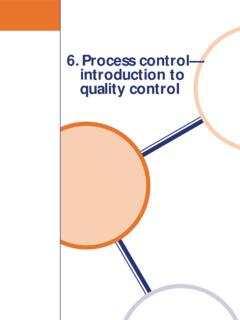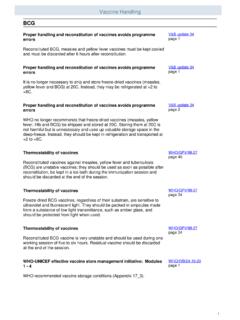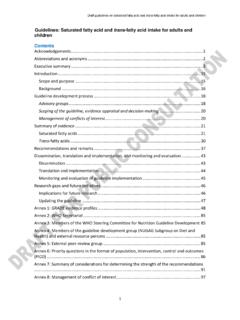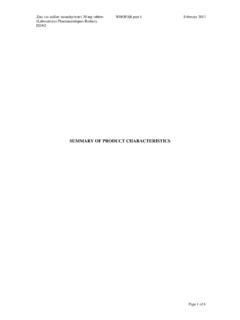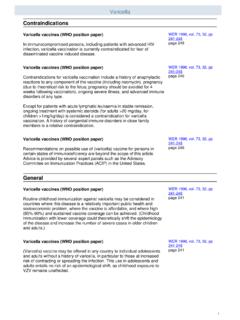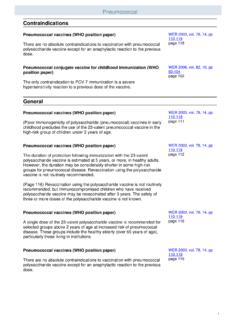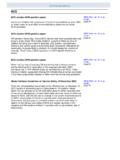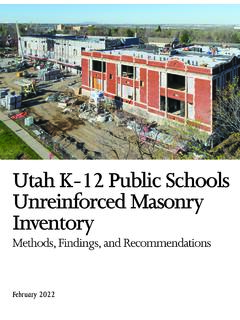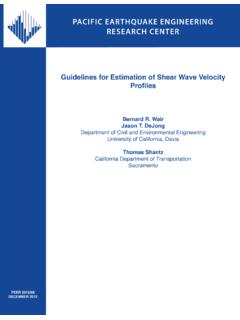Transcription of 3.2 Disaster risk factors – hazards, exposure and ...
1 WHO Guidance on Research Methods for Health Emergency and Disaster Risk risk factors hazards, exposure and vulnerabilityAuthorsDell D. Saulnier, Department of Global Public Health, Karolinska Institute, Stockholm, Mani Dixit, National Society for earthquake Technology, Kathmandu, Nepal; Asian Disaster Reduction and Response Network (ADRRN), Kuala Lumpur, Raquel Nunes, Warwick Medical School, University of Warwick, Coventry, United Kingdom. Virginia Murray, Public Health England, London, United learning objectives To understand the key factors to consider when developing a study to assess risk factors relevant to health emergency and Disaster risk management (Health EDRM), including:1. How hazards, exposure , and vulnerability/capacity create Disaster The unique challenges of defining, identifying and measuring risk in Disaster Common issues of validity and quality in causal research in How to conduct a study to assess Disaster risk Introduction In disasters, there are three broad areas of risk to health: the hazard that can cause damage, exposure to the hazard and the vulnerability of the exposed population (see also Chapters and ) (1).
2 Disaster research often strives to show that these risks affect morbidity, mortality or well-being in some way. This provides evidence to inform decisions relevant to Health studies look for a risk factor that, if removed, would prevent the associated adverse outcome. A hypothesis is developed to explain the relationship between exposure to the risk factor and the outcome, and assumptions are made about what other factors (usually called confounding factors ) might influence the relationship. The conclusions that can be drawn depend on how well these elements are addressed and measured when conducting the study and interpreting the results. Research on disasters requires critical reflection around choosing and measuring risk factors because of the pragmatic difficulties inherent with conducting research in Disaster settings (2).
3 This chapter outlines areas of 152disaster risk and discuss how research can be used to determine the causes of the problem, and how these causes and the size of their effects can be measured reliably. Chapter provides additional information on how to undertake and interpret the statistical analyses that would help with this. HazardsDisasters often follow a hazard that negatively impacts a population (3). Hazards can take many forms:Natural: earthquake , landslide, tsunami, cyclones, extreme temperatures, floods, or droughtsBiological: disease outbreaks including human, animal, and plant epidemics and pandemicsTechnological: chemical and radiological agent release, explosions, and transport and infrastructure failuresSocietal: conflict, stampedes, acts of terrorism, migration, and humanitarian emergenciesMany ways to classify hazards exist (see Table for an example).
4 Hazards can occur individually, sequentially or in combination with each other. A primary hazard can be followed by secondary hazards, as seen with the earthquake , tsunami, and radiological hazards in the 2011 East Japan Disaster (Chapter ) (4 5). Timing, severity, geographic location, and frequency are important characteristics of hazards. Hazards can have a short or long duration, and can have different impacts depending on the time of day, week or month when they happen (6). They can be sudden onset, like an avalanche, or develop slowly over time as the result of a combination of factors . Deforestation, for example, is a slow onset hazard which can stem from factors such as limited resource management, land use planning, economic opportunities, and climate change.
5 Hazards can be severe in their scope and impact or small-scale and localized. Hazards can happen infrequently, like radiological incidents, or frequently, like hurricanes and typhoons. How important these characteristics are and how they are translated to risk is relative to the population exposed to the hazard. For example, areas of the southern USA frequently experience hurricanes of varying strengths. People living in mobile homes in these regions are more likely to evacuate their homes during a hurricane because they perceive their risks to be high, based on prior experience with hurricanes and the strength of the hurricane, compared to those who live in more strongly built structures (7). Guidance on Research Methods for Health Emergency and Disaster Risk Management153 Table Truncated WHO Classification of Hazards (8)
6 GroupsSub-groupsExamples of main typesNaturalGeophysicalEarthquake, geophysically triggered mass movement, volcanic activityHydrologicalFlood, wave action, hydrometeorological triggered mass movementMeteorologicalStorms, extreme temperatureClimatologicalDrought, wildfire, glacial lake outburstBiologicalAir-, water-, and vector-borne diseases, animal and plant diseases, food-borne outbreaks, antimicrobial resistant microorganismsExtraterrestrialImpact, space weatherHuman-inducedTechnologicalIndustr ial hazard, structural collapse, fire, air pollution, infrastructure disruption, cybersecurity, hazardous materials (including radiological), food contaminationSocietalArmed conflict, civil unrest, financial crisis, terrorism, chemical, biological, radiological, nuclear, and explosive weaponsEnvironmentalEnvironmental degradationErosion, deforestation, salinization, sea level rise, desertification, wetland loss/degradation, glacier retreat/meltingCase Study describes the interaction of hazards with risks, using the example of earthquakes and masonry in 4 Case Study Structural risks during a hazard: Earthquakes and low-strength masonry in NepalLow-strength masonry of stone or bricks with mud mortar is the dominant building typology in Nepal and has been used as a building material since ancient times.
7 It is still used in many parts of the country. Construction of early monuments, temples and residential buildings was generally limited to materials that were readily available and easily worked by local artisans. The trend at present is to use cement-based construction, especially in urbanizing April 2015, an earthquake and its aftershocks killed more than 8800 people and injured more than 22 000, largely due to the damage to low-strength masonry structures. Among other factors , the impact on life depended on building vulnerability and the evolution of construction methods. Indeed, fatalities from the earthquake indicated that, on average, there had been a reduction in building vulnerability in urban areas, whereas buildings in rural areas remained highly vulnerable.
8 A post- Disaster needs assessment reported the following damage to houses associated with masonry strength (9):Low-strength masonryCement masonryReinforced concreteTo t a lPartially damaged173 8 6765 85916 971256 697 Fully damaged474 02518 2146 613498 852 The National Society for earthquake Technology in Nepal started conducting training on earthquake resistant construction of vernacular buildings for masons in the late 1990s, and the government has taken the lead with national and international support, especially after the 2015 earthquake . There remains a continuing need for the institutionalization of a comprehensive, multi-tier and hands-on training certification programme to teach further skills in improving seismic performance of buildings and for developing nationwide capacities in earthquake -resistant Guidance on Research Methods for Health Emergency and Disaster Risk ExposurePopulations and societies need to be exposed to a hazard to be affected by it.
9 Populations are often talked about as being directly or indirectly affected. Direct effects include injury, illness, other health effects, evacuation and displacement, and economic, social, cultural, and environmental damages. Indirect effects refer to additional consequences over time that cause unsafe or unhealthy conditions from economic, infrastructure, social, or health and psychological disruptions and changes. One of the major challenges in Disaster research is measuring who has been affected and when. Determining which effects can be attributed to a Disaster is complex, as there are multiple indirect pathways to an outcome (Figure ). This is further complicated when populations are repeatedly or continuously exposed to a hazard, and when the time until the effects appear varies.
10 For instance, disruptions to the health system and persistent stress from exposure to a hazard can lead to a greater burden of chronic conditions that may not present until months or years after a Disaster . Figure Example of the indirect impact of droughts on health (10)Water shortagesNutrition-relatede ectsMental healthe ectsVector-bornediseaseAirborne anddust-relateddiseaseWater relateddiseaseOther: Injuries, migration-related healthissues, wild res,health systemand infrastructureimpacts, pricesMigrationDroughtIndirecthealthe ectsIncreasedmorbidity,mortalityImpacts onlivelihoods:loss of crops,livestock, sheries, etcInfrastructure: health, sanitation, available resourcesBaseline public health: capacity for resilienceCase Study shows how exposure risk can be reduced by changes to organizational Study Changing organizational behaviour to reduce exposure risk.

